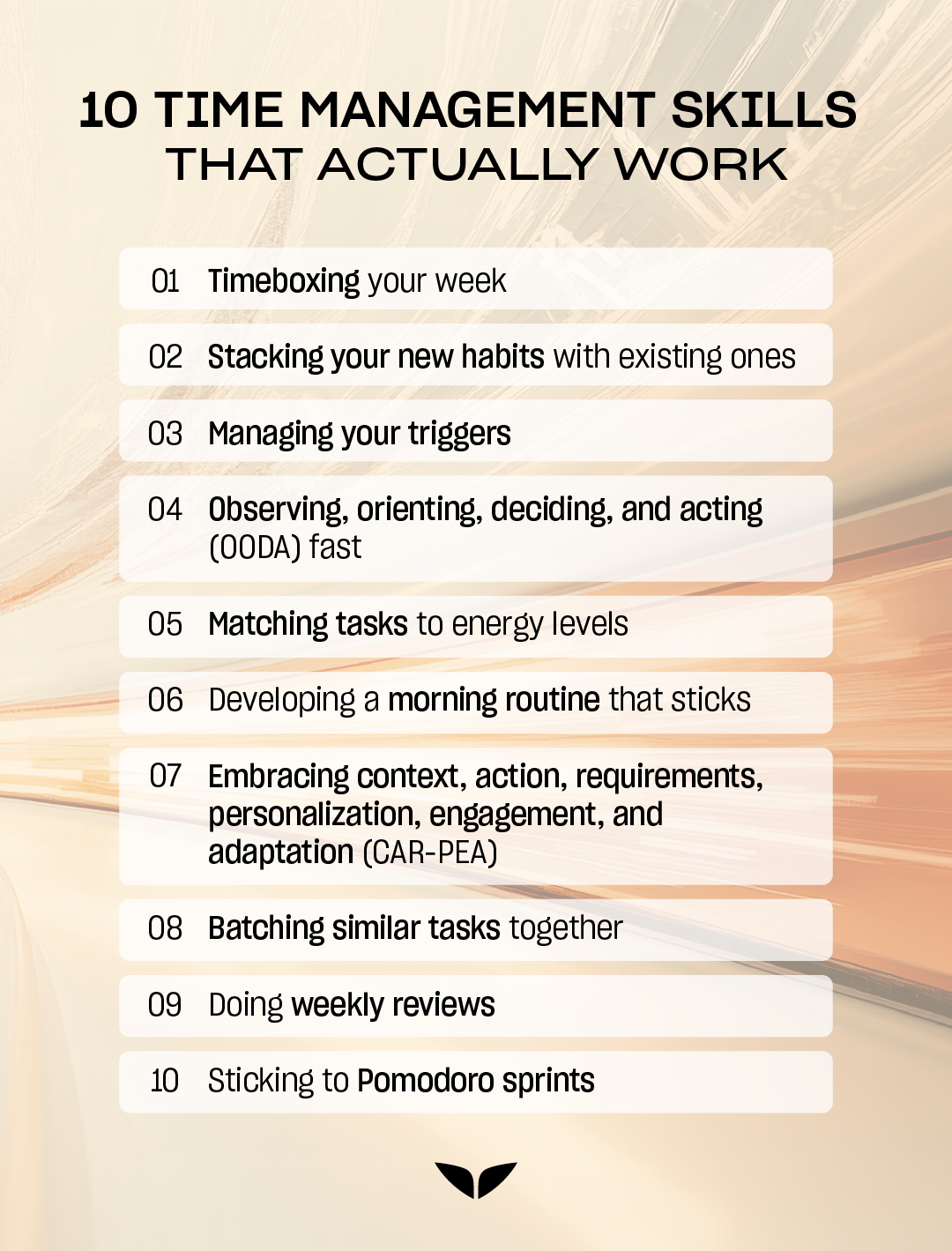The clock ticks on, whether you’re ready or not.
Morning can easily slip into night, with your hours all threaded with messages, meetings, and moments that seem to choose themselves.
Amidst it all, you may find yourself brushing off that side hustle you’ve been dreaming of, your trip to the gym, or that due family visit. You may be telling yourself, “It will happen later”—after the call, after the reply, after the quick task. But it never does.
If you’re up at night lately, wondering how life took this turn? It’s time to learn how to improve time management skills that protect your attention, instead of packing more to-do lists in your day. Because the truth is, it’s all about the art of being indistractable.
When your peace is guarded, it’s easier to be deliberate about your days. And time becomes something you own, instead of it owning you.
What time management is and what it really isn’t
Time management, simply put, is an attention game. What it’s not is a volume game—that is, about cramming more things into the calendar, like we’ve been told to believe by some self-help books and productivity influencers.
According to Nir Eyal, a habit formation expert and author of the book Indistractable, it’s important to know the difference between traction and distraction. The former encompasses the actions that you take to make something work, while the latter is what pulls you away from them.
“If you’re not spending your time doing what you plan, you are off track,” he says in his Mindvalley program. And that can only mean one thing: you’re distracted.
Understanding this nuance matters; it’s the only way to learn how to stop procrastinating. In an age where people check their phones 50 times a day and artificial intelligence (AI) integration at work is a benchmark now, willpower alone just doesn’t work.
The importance of time management skills
How you own your time determines whether your energy is spent on what moves the needle or diffused across demands that barely move you forward.
If you’re not spending your time doing what you plan, you are off track.
— Nir Eyal, trainer of Mindvalley’s Becoming Focused and Indistractable
And this matters more than you think. With AI projected to take over nearly 30% of working hours globally by 2030, the way we work with time is no longer a matter of preference.
So, the main goal here is to focus on what you can weed off, rather than what you can pile on. All while being kind to yourself in the process of change.
Per Nir’s wisdom, time management is a journey that is all about understanding where your attention goes, where it slips, and most importantly, how you can swiftly get it back. As he points out in Becoming Focused and Indistractable, “we are only powerless if we think we are.”
Mindvalley’s founder and CEO, Vishen, shares the same sentiment. In Super Productivity, one of the Mindvalley programs he leads, the antidote to powerlessness is replacing reaction with intention. His contrarian approach? “Measure how many decisions you’re making,” he says.
So, forget about the total hours you log and all those “how to be more productive” articles. The yardstick to work with is the number of times you actively choose a productive move over the course of the day. That, in the end, is how you know you’ve made the most of your moments.
We are only powerless if we think we are.
— Nir Eyal, trainer of Mindvalley’s Becoming Focused and Indistractable
10 top ways to improve time management skills
Time management works best when it feels like second nature. It’s about setting up your days well, so the important things can happen… all without you feeling like you’re up against the wall and then feeling bad when your list goes unchecked at the day’s end.
“Success is measured by whether you did what you planned to do,” says Nir. And contrary to what bloated productivity advice out there would tell you, all you need is truly a list of simple systems, on top of a “quick learner” mindset. Together, these should keep your priorities in plain sight, protect your focus, and match your energy to the right work at the right time.
Not sure where to start? Explore these time management skill examples, each one backed by time management experts to help shift how you move through the day.
1. Timeboxing your week
Instead of leaving your calendar full of open space, carve out time for all of your tasks. Nir calls this approach timeboxing, and it’s as simple as deciding what you’ll do and when you’ll do it. Even those small, minute personal moments.
To start:
- Think of your weeks in “templates.” This way, you view a block as the canvas for your ideal day-to-day pace, which can change week by week.
- Block even your time off for rest, movement, learning, and connection. For an easier experience, every block should have a standard, overarching theme.
- Color-code categories. Use labels like “work,” “personal,” and “health” liberally so you can see at a glance if your week is balanced.
With this approach, everything that matters to you actually has a place in your life. Not sure where to start? Follow Nir’s footsteps on timeboxing below:
2. Habit-stacking
“About 40% of our daily behaviors are driven by habit,” explains Nir. And sometimes, adopting a new one for self-mastery can feel overwhelming. So why not piggyback anything you already do without thinking? It’s how the new habit can become effortless.
Some ideas to try if you’re unsure what this approach can look like:
- Do a one-minute stretch daily while your coffee brews in the morning.
- Listen to a language-learning app on your walk to the train station.
- Review your top three priorities for the day right after you close your laptop from your first meeting.
- Meditate for two minutes after brushing your teeth at night.
You can even fold these micro-habits into your timeboxing schedule for greater effect. No need to reinvent the wheel when you can layer the new onto the old.
3. Trigger management
Distraction doesn’t happen in a vacuum; triggers spark it. Nir divides them into two types:
- External triggers. Think phone pings, incoming emails, and having a coworker unexpectedly sashaying towards your desk.
- Internal triggers. They’re driven by your emotional or mental states, like boredom, restlessness, or discomfort.
To overpower them, start noticing the moment they occur.
To master the external triggers, simply turn off nonessential notifications and set clear “do not disturb” windows. These simple boundaries are key for how to improve time management skills at work. And they carry over just as well into your off-the-clock hours.”
As for when the internal ones hit? Have a pre-decided response, from taking a short walk to stretching your body, until whatever feeling’s overwhelming you passes.
The point of it all is to remain intentional as you weed off distractions.
4. The OODA loop
This one’s a gem when it comes to professional efficiency. Because ultimately, speed matters more than perfection in most fields of work.
The OODA loop stands for:
- Observe: Take in what’s actually happening, not what you assume is happening.
- Orient: Size up the situation and spot your options.
- Decide: Pick a direction without waiting for every variable to align. Limit the time you spend weighing options.
- Act: Test things put within deadlines in real time. Adjust your strategy later if you have to, but only after you’ve moved.
Applied well, this approach by Vishen helps you make decisions without getting stuck in overthinking. Acting from a place of certainty, he teaches, beats waiting for total clarity, since learning in action is what accelerates progress, in the end.
“A team that can make five 80%-sure decisions in a week towards a project,” he describes, “is better than a team that can make one 100%-sure decision.”
Even if you pivot later, you’ll have moved forward instead of stalling.
5. Task-energy mapping
Productivity is, above all, about energy management. So, pay attention to when you’re most alert and creative during your week-on-week observation, and assign future tasks accordingly.
To know where you are in becoming more focused:
- Map your energy curve. Track your alertness over a week to spot natural peaks and dips. You can try any of the best habit-tracking apps for this to help you out.
- Spot those high-energy hours. Park them for deep work or strategic projects.
- Save admin tasks for slower, “slumpier” moments. You should handle repetitive motions like replying to emails, taking calls, and planning your monthly calendar during these low-energy windows.
- Break those dip patterns. If you’ve noticed that you’re prone to mid-afternoon crashes, then strategize against them with simple steps. They can be brisk walks, healthy snacks, or different work locations or seating positions.
Now, here’s the thing: how you adopt this approach is unique to you, and only you. Everyone, alas, has different energy rhythms. So, comparing your focus to someone else’s is like measuring in a different time zone.
And if others question your approach? Just keep calm and keep going. “The power to change is within you,” Nir points out. “Don’t believe anyone who tells you differently.”
6. A perfect morning routine
The start of your day is crucial because that’s when your brain transitions from theta waves (dreamlike creativity) into alpha waves (calm focus). The latter’s when it’s easier to sink into deep work mode and creative tasks like strategizing, writing, coding, or designing.
To lock this in:
- Identify your “deep work window.” Even 60–90 minutes is legit and enough.
- Keep it phone-free. Use “do not disturb” signs on Slack or WhatsApp, or physically remove your phone from reach.
- Prep your environment the night before. Have everything you need ready so you can start your day without friction.
Time-block this window so it’s non-negotiable. The more you protect it, the easier it is to solidify a morning routine that anchors your entire day.
7. The CAR–PEA method
Vykintas Glodenis, Mindvalley’s resident AI expert and trainer of Amplify with AI, believes that productivity grows when reminders exist to pull you back into focus. And if you’re already looking into how to learn AI, then his CAR-PEA framework may be your best friend.
The framework turns recurring tasks into a “nudge system” tailored to you, your responsibilities, and your goals. These prompts arrive in the same conversation or tool you already use, and your responses train the system to anticipate your needs. Over time, the “nudges” become more nuanced, appearing precisely when you’re most likely to drift.
Here’s how it works:
- C is for “context”: Give your AI assistant or task manager the whole background of what you want to achieve.
- A is for “action”: Spell out the specific outcome you expect every time it prompts you.
- R for “requirements”: Add personalization, the tone you want it to use, and the approach that keeps it engaging.
- P is for “personalization”: Adapt prompts so they speak in your preferred style and format.
- E is for “engagement”: Frame them in ways that spark your interest and make action feel effortless.
- A is for “adjustment”: Refine prompts over time so the system learns and improves with you.
Done this way, each prompt lands like a message from a coach who understands your goals and your quirks. As Vykintas says, “Make it interesting enough that you want to open it.”
8. Strategic batching
Constantly jumping between tasks can drain your energy faster than you think. On the contrary, grouping similar activities keeps your brain in one mode for longer, as you can get through them with more ease.
To try this:
- Batch by category. For example, put all your emails into one time block and clear them at once. Do the same with your calls so you are not stopping and starting all afternoon.
- Batch by the extent of their creative nature. Have one block for writing and another for strategic thinking. This way, you’re tackling them with your state of mind.
- Protect the boundaries between tasks. Keep unrelated ones out of any single batch so the “mental thread” behind them stays intact.
You will finish more in less time and still have energy for the parts of life that matter after work.
9. Weekly reviews
A plan only works if you keep learning from it. Nir suggests making time each week to ask yourself, “Where did I stick to the plan? Where did distraction win?”
Vishen takes this further with a decision log, pointing out that “the people who are right a lot often change their mind” because they understand why.
To make this part of your week:
- Lock in a review ritual. Spend 15 minutes every Friday afternoon looking back at your week before you shut down for the weekend.
- Capture your calls. Keep a simple note of big decisions as they happen, why you made them, and how confident you felt.
- Spot the patterns. Maybe you lose focus whenever you check your emails before lunch. Or your best ideas tend to show up after your morning walks. Whatever the patterns are at work, notice them and leverage them to your advantage.
- Be open to adjusting your plans. Use what you learn to tweak your timeboxing, batching, or energy mapping for the week ahead.
Over time, this becomes less about tracking mistakes and more about building a system that gets sharper every week.
10. Pomodoro sprints
Francesco Cirillo’s Pomodoro Technique is a simple way to train your brain for short bursts of focused work. The structure makes it easier to get started and keeps distractions at bay.
And it’s beneficial to you to have attention deficit hyperactivity disorder (ADHD), since time blindness, executive dysfunction, and trouble starting can turn tasks into Sisyphean battles. Thankfully, Pomodoro’s short, structured blocks and built-in pauses have been found to help remedy these hiccups.
A helpful way to think of it is like chopping a large project into sprints, so each one feels achievable and not overwhelming.
Here’s a practical way to bring it into your day:
- Pick a task that you’ve been stalling on. Maybe it’s a complicated write-up or sifting through your emails and calendar invites.
- Set a timer and work for 25 minutes. No doomscrolling, no switching tabs, only pure presence with the work at hand.
- When it rings, pause for five minutes. Stand, sip water, and breathe properly.
- Repeat the whole process four times. Then take a more extended break that runs anywhere from 15 to 30 minutes.
- Notice what feels best for your rhythm. On some days, you might need 15-minute sprints, while on other days, they can be longer or shorter.
These small cycles create a rhythm you can actually sustain, turning work into a series of wins that stack up. Pair them with timeboxing or batching, and you’ll have a workflow that not only gets things done but also makes your day feel so much lighter.

14 best books and podcasts on time management skills
Some lessons in time management you pick up through trial and error. Others come from voices that have been living, testing, and refining these ideas for decades.
Together, they form a running conversation in your ear about what it really takes to own your time… no matter the format they take on.
So, whether bound in print or streamed through your headphones, these books and podcasts distill years of experimentation into ideas you can apply today.
Books
- Indistractable by Nir Eyal. Here, Nir dives deep into the tug-of-war between traction and distraction and gives you the tools to win it daily. It’s practical, science-backed, and loaded with tactics you can start using before you even finish the first chapter.
- The Code of the Extraordinary Mind by Vishen. Learn all about the “brules” (bullsh*t rules) that keep society on autopilot. His systems-thinking approach shows you how to break those patterns and design your time around what truly moves your life forward.
- Deep Work by Cal Newport. This book is a love letter to undisturbed focus. The golden nugget to expect here? Cal’s strategies for building a work environment where deep focus becomes your default state.
- Eat That Frog! by Brian Tracy. A quick, no-nonsense guide to tackling your most important task first thing in the day. Brian’s 21 bite-sized tips make it easy to break procrastination and reclaim momentum.
- The Joy of Missing Out by Tanya Dalton. In this book, Dalton challenges the glorification of “busyness” and instead teaches you to reclaim your hours by stepping back, saying no, or letting go of “shoulds.” It’s part-time management, part life philosophy, and it reads like a permission slip to slow down without losing momentum.
- Atomic Habits by James Clear. This book is habit science in plain language. James’s “1% better” concept shows how small tweaks compound into huge results that uplevel your life. If you’ve struggled to stick to a time-management system, this can help you build it into muscle memory.
- 4,000 Weeks: Time Management for Mortals by Oliver Burkeman. Instead of promising you can “do it all,” Burkeman argues you can’t… And that’s liberating. He reframes productivity as accepting your limits and choosing what to neglect with intention. It’s perfect for readers tired of hustle-culture preaching.
Podcasts
- The Tim Ferriss Show. In his podcast, The 4-Hour Workweek author drills deeper into the daily habits, time systems, and mental models of world-class performers. Consider each episode his extended masterclass in high-level productivity.
- The Mindvalley Podcast. Led by Vishen and his co-host Megan Pormer, this show features leading thinkers in productivity, personal growth, and lifestyle design. Expect fresh, future-forward perspectives on how to shape your days and your career.
- Beyond the To-Do List. Here, host Erik Fisher talks to experts and everyday high-achievers about the practical side of managing work and life. It’s all about the tools and tactics you can actually try today.
- The Productivity Show. From the team at Asian Efficiency, this one is strategy-heavy, tackling everything from time blocking to focus hacks. If you want to trim hours of wasted effort each week, their step-by-step approach is a solid place to start.
- Before Breakfast. In this show, author and time management expert Laura Vanderkam delivers short, daily tips for managing time better. Each episode is under ten minutes, perfect for fitting into your morning routine.
- WorkLife with Adam Grant. One thing’s clear: organizational psychologist Adam takes you inside the minds of creative, effective people. By featuring them on his podcast, he reveals how they manage their time, energy, and attention in surprising ways.
- The Marie Forleo Podcast. Marie’s mix of mindset coaching and tactical advice makes this podcast part pep talk, part productivity playbook. Her show covers everything from overcoming procrastination to building a business without burning out.
BONUS: Your time-management optimized day schedule
Sometimes, all you need is a place to start… And this schedule template is a time-management framework that can make your day less blurry and more purposeful.
It pulls together the time-management skills mentioned and threads them into a flow you can actually live with. Of course, tweak the details according to where you are in life.
Adjust the details to fit your priorities, energy levels, and season of life; the point is to create a rhythm that works for you, not against you.
| Time | Activity | Key skills applied | Why it matters |
| 7:00–7:30 AM | Morning movement or mindfulness | Habit-stacking | Activates body and mind, sets tone for the day |
| 7:30–9:00 AM | Deep work session | Perfect morning routine, timeboxing | Peak mental clarity for creative or strategic tasks |
| 9:00–9:15 AM | Short break | Energy management | Prevents burnout, maintains focus |
| 9:15–11:00 AM | Second deep work block | Timeboxing | Leverages the remaining morning focus before meetings |
| 11:00–11:15 AM | CAR–PEA prompt review | CAR–PEA method | Nudges you back on track and personalizes the workflow |
| 11:15 AM–12:30 PM | Problem-solving or high-focus tasks | OODA loop | Makes decisions quickly and effectively |
| 12:30–1:30 PM | Lunch, followed by light movement | Energy management | Refuels body and refreshes mind |
| 1:30–3:00 PM | Strategic batching of admin tasks | Strategic batching | Minimizes context-switching fatigue |
| 3:00–3:15 PM | Pomodoro sprint setup | Pomodoro Technique | Keeps energy up during afternoon slump |
| 3:15–4:15 PM | Pomodoro sprints (2–3 rounds) | Pomodoro Technique | Maintains momentum on smaller tasks |
| 4:15–4:30 PM | Short reflection break | Reflection points | Identifies what worked today and what didn’t |
| 4:30–5:30 PM | Final wrap-up and next-day planning | Task-energy mapping | Aligns tomorrow’s work with peak energy slots |
| Evening | Unstructured personal time | Trigger management | Protects rest and recovery by removing work-related triggers |

Great change starts here
Time is the one currency you can never earn back. With these strategies fresh in your mind, the next step is putting them into play… without letting the process overwhelm you.
That is where the free Becoming Focused and Indistractable masterclass with Nir Eyal and Vishen Lakhiani comes in. In just 60 minutes, you will learn how to:
- Turn distractions into traction, so your actions match your highest values,
- Use timeboxing to design a week that reflects the life you actually want to live,
- Reframe internal triggers like boredom or stress into gateways for focus,
Protect your attention from digital overwhelm without quitting the tools you love, and - So much more.
Wioleta Wydrych, a success coach for coaches from Glossop, United Kingdom, began this journey feeling scattered and stalled on her projects. But within weeks, she was ahead of schedule and launching again with confidence. She shares:
Learning with others in this course helped me to implement so much that I feel on fire now. Today, I’m more organized, aware when I get distracted, and I know exactly how to respond. This is exactly what I needed to get more done.
Her story is proof that a focused mind is a skill that you, or anyone at all, can master, not some innate gift you’re born with. And with the proper guidance, it’s only a matter of time before you can take full command of your hours, your energy, and your goals.
Your time is already yours to reclaim. Mindvalley is here to make sure you don’t waste another moment.
Welcome in.










